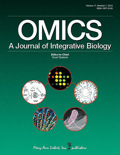
BIOINFORMATICS
Scope & Guideline
Leading the Charge in Bioinformatics Discoveries
Introduction
Aims and Scopes
- Computational Genomics and Transcriptomics:
This area includes the development and application of algorithms and models for analyzing genomic and transcriptomic data, aiming to derive biological insights from sequencing technologies. - Machine Learning and AI in Bioinformatics:
The journal showcases research that employs machine learning and AI techniques to make predictions, identify patterns, and enhance the interpretation of biological data. - Structural Bioinformatics:
Research focused on protein structure prediction, folding, and interactions, utilizing computational methods to understand biological mechanisms at the molecular level. - Systems Biology and Network Analysis:
This scope encompasses the modeling and analysis of complex biological systems, including gene regulatory networks, metabolic pathways, and protein-protein interactions, often using graph-based approaches. - Metabolomics and Proteomics:
The journal covers studies that analyze the metabolome and proteome using high-throughput techniques, focusing on the integration of these data types with genomic information. - Bioinformatics Tools and Software Development:
A significant portion of articles is dedicated to the development of new computational tools, algorithms, and software that facilitate bioinformatics research and data analysis.
Trending and Emerging
- Integration of Multi-Omics Data:
There is an increasing trend in studies that integrate various omics data types (genomics, transcriptomics, proteomics, metabolomics) to provide a more holistic view of biological systems. - Deep Learning Applications:
The application of deep learning techniques in bioinformatics is rapidly increasing, with numerous studies focusing on their use for tasks such as protein structure prediction, drug discovery, and gene expression analysis. - Graph-Based Approaches:
Research utilizing graph-based methodologies for modeling biological networks and interactions is gaining traction, reflecting the complexity of biological systems and the relationships between various components. - AI-driven Drug Discovery:
The journal is witnessing a surge in articles related to the use of AI and machine learning in drug discovery processes, including predicting drug-target interactions and optimizing drug formulations. - Real-Time Data Analysis and Applications:
There is a growing emphasis on tools and methodologies that support real-time data analysis, particularly in the context of rapidly evolving fields such as infectious disease research and personalized medicine.
Declining or Waning
- Traditional Statistical Methods without Machine Learning:
There has been a noticeable decline in the publication of papers focusing solely on classical statistical methods for data analysis, as more researchers adopt machine learning approaches that offer greater flexibility and predictive power. - Single-Method Studies:
Papers that present single-method approaches without integrating multiple techniques or data types are becoming less common, as the field increasingly values interdisciplinary and integrative methodologies. - Basic Sequence Alignment Techniques:
The focus on basic sequence alignment methods is waning, with more emphasis now placed on advanced algorithms that incorporate machine learning and deep learning techniques. - Static Data Analysis:
Research that centers solely on static analyses of biological data is declining, as there is a growing trend toward dynamic modeling and time-series analysis.
Similar Journals

Molecular Systems Biology
Exploring the Intersection of Biology and TechnologyMolecular Systems Biology, published by SpringerNature, is a premier open access journal that has been a cornerstone in advancing the fields of biological science since its inception in 2005. With its ISSN 1744-4292, this journal exemplifies high scholarly standards, boasting an impressive suite of impact factors, including Q1 rankings across various disciplines such as Agricultural and Biological Sciences, Biochemistry, Genetics and Molecular Biology, and more, highlighting its significant contribution to the scientific community. The journal offers robust access options to facilitate innovative research dissemination, reaching a global audience while maintaining a commitment to fostering collaboration and dialogue among researchers, professionals, and students. With a focus on integrating quantitative approaches to biological systems, Molecular Systems Biology plays a vital role in addressing complex biological questions, paving the way for groundbreaking discoveries and advancements in healthcare, environmental sustainability, and functional genomics.

JOURNAL OF PROTEOME RESEARCH
Catalyzing Research in the World of ProteomicsJOURNAL OF PROTEOME RESEARCH is a premier publication in the field of proteomics, disseminating cutting-edge research and methodologies that drive advancements in biochemistry and molecular biology. Published by the American Chemical Society, this esteemed journal boasts a robust impact, as evidenced by its Q1 rankings in both Biochemistry and miscellaneous Chemistry categories for 2023. With a reputation bolstered by a solid Scopus ranking—#64 out of 408 in General Chemistry and #80 out of 438 in Biochemistry—the journal serves as an essential resource for researchers, professionals, and students aiming to deepen their understanding of protein functions and interactions in biological systems. Although it does not operate under an open-access model, the JOURNAL OF PROTEOME RESEARCH remains a critical platform for scholarly discourse, committed to publishing high-quality, peer-reviewed articles through 2024 and beyond. Scholars are encouraged to engage with the pioneering studies and reviews that shape the future of proteomics.

NAR Genomics and Bioinformatics
Pioneering Research in Genomics and Data ScienceNAR Genomics and Bioinformatics, published by Oxford University Press, is a leading open-access journal that has been at the forefront of research in genomics and computational biology since its inception in 2019. With an impressive impact factor and a consistent ranking in the Q1 category across multiple fields—namely Applied Mathematics, Computer Science Applications, Genetics, Molecular Biology, and Structural Biology—this journal stands as an influential platform for disseminating innovative findings and methodologies. Researchers and professionals have the opportunity to engage with high-quality, peer-reviewed articles that reflect the latest advancements in both theoretical and applied aspects of bioinformatics. The journal's commitment to open access ensures that groundbreaking research is accessible to a global audience, fostering collaboration and knowledge sharing within the scientific community. The country of publication is the United Kingdom, with a dedicated editorial team striving to maintain the highest standards of academic excellence.

PROTEOMICS
Pioneering discoveries in protein function and interaction.PROTEOMICS is a leading journal focused on the rapidly evolving field of proteomics, published by WILEY in Germany. With a solid reputation established since its inception in 2001, it has continually contributed to the understanding of protein functions and interactions within biological systems. As part of its commitment to academic excellence, PROTEOMICS is ranked in the second quartile for both Biochemistry and Molecular Biology categories (2023), reflecting its significant influence in advancing research in these areas. Although it does not currently provide open access options, it remains a vital resource for researchers, professionals, and students keen to explore innovative methodologies and findings in proteomic research. By publishing groundbreaking studies that bridge theoretical knowledge with practical applications, PROTEOMICS plays a crucial role in enhancing our understanding of molecular processes and driving forward advancements in the life sciences.

MOLECULAR GENETICS AND GENOMICS
Fostering Collaboration in Genetic and Genomic SciencesMOLECULAR GENETICS AND GENOMICS is a distinguished journal published by SPRINGER HEIDELBERG that serves as a pivotal platform for the communication of cutting-edge research and developments in the fields of genetics, molecular biology, and medicine. With an ISSN of 1617-4615 and an E-ISSN of 1617-4623, this journal has established itself since its inception in 1994 as a significant resource for researchers aiming to explore the complexities of genetic interactions and their implications in various biological systems. The journal is indexed in Scopus, with respectable rankings in the Genetics, Molecular Biology, and Biochemistry categories, showcasing its position within the academic community. It is categorized in the 2023 rankings as Q3 in Genetics, Q2 in Medicine (miscellaneous), and Q3 in Molecular Biology, indicating its relevance and quality in the scientific discourse. The journal also promotes open access, ensuring that researchers and professionals can easily share and advance knowledge in the rapidly evolving disciplines of molecular genetics and genomics. As the journal continues to bridge the gap between experimental and theoretical research, it presents a vital space for innovation, fostering collaborations and scholarly exchange among its readership.

npj Systems Biology and Applications
Advancing the Frontiers of Systems Biologynpj Systems Biology and Applications, published by NATURE PORTFOLIO, is a premier open-access journal that has been at the forefront of the field since its inception in 2015. With a commendable focus on the interdisciplinary integration of applied mathematics, biochemistry, computer science, and drug discovery, the journal currently enjoys a Q1 ranking across multiple categories, showcasing its significant impact within the scientific community. In 2023, it ranked 70 out of 635 in Applied Mathematics and holds a notable place in the 89th percentile, confirming its esteemed reputation among researchers. Situated in the United Kingdom, this journal not only promotes innovative research in systems biology but also serves as an essential platform for the dissemination of high-quality studies that delve into modeling, simulation, and the application of biological systems in drug discovery processes. With an open-access model, authors can reach a broad audience, enhancing collaborations and advancing knowledge across disciplines, making it an indispensable resource for researchers, professionals, and students alike seeking to contribute to the evolving landscape of systems biology.

OMICS-A JOURNAL OF INTEGRATIVE BIOLOGY
Advancing integrative biology for a collaborative future.OMICS-A JOURNAL OF INTEGRATIVE BIOLOGY, published by Mary Ann Liebert, Inc., is a leading peer-reviewed journal dedicated to the field of integrative biology, encompassing Biochemistry, Biotechnology, Genetics, Molecular Biology, and Medicine. With an ISSN of 1536-2310 and E-ISSN of 1557-8100, this esteemed journal stands out with its commitment to advancing scientific knowledge and research within its scope, particularly effective from its inception in 2002 through to 2024. The journal holds a commendable position in various Scopus ranks, notably achieving a Q2 quartile in Biotechnology and Medicine (miscellaneous), and continues to exemplify rigorous scholarship with an impactful focus on cross-disciplinary integration. Although not an open-access publication, OMICS ensures that its readership has access to significant findings that shape contemporary biological discourse. Researchers, professionals, and students alike are encouraged to contribute to and explore this journal, as it not only advances knowledge but also fosters collaboration among diverse scientific communities.

Journal of Integrative Bioinformatics
Advancing the Frontiers of Bioinformatics ResearchJournal of Integrative Bioinformatics, published by WALTER DE GRUYTER GMBH, is a leading open-access journal that has been at the forefront of the field since its inception in 2004. With an E-ISSN of 1613-4516, it serves as a crucial platform for researchers engaged in the interdisciplinary study of bioinformatics, blending insights from biology, computer science, and mathematics. Based in Germany, the journal is recognized for its impact in the realm of general medicine, boasting a Scopus rank of #172 out of 636 and placing in the 73rd percentile of its category. The journal continuously strives to disseminate high-quality research contributions that unify experimental and computational approaches to address complex biomedical questions. Targeted towards academics, professionals, and students alike, the Journal of Integrative Bioinformatics provides essential access to innovative research that enhances our understanding of integrative methodologies in medicine and beyond, especially with converged years spanning from 2008 to 2024.

International Journal of Data Mining and Bioinformatics
Bridging Data Science and Biological Insights.The International Journal of Data Mining and Bioinformatics, published by InderScience Enterprises Ltd, stands as a crucial platform for researchers and professionals dedicated to the intersection of data science and biological informatics. With its ISSN 1748-5673 and E-ISSN 1748-5681, this journal captures the essence of innovative research from 2006 to 2024. Though indexed in the Q4 category for Biochemistry, Genetics and Molecular Biology and Information Systems, it maintains a respectable Q3 status in Library and Information Sciences, reflecting its growing influence within the academic community. The journal also provides insightful contributions to the fields of big data analytics, machine learning, and computational biology. Although it is not currently an open-access journal, its relevance is underscored by its Scopus rankings, indicating a solid standing in the disciplines it encompasses. Researchers, students, and practitioners in data mining and bioinformatics are encouraged to explore the findings and methodologies presented, paving the way for future innovations in this dynamic field.

PROTEINS-STRUCTURE FUNCTION AND BIOINFORMATICS
Unlocking the Secrets of Protein DynamicsPROTEINS - STRUCTURE FUNCTION AND BIOINFORMATICS, published by WILEY, is a leading journal in the fields of biochemistry, molecular biology, and structural biology, recognized for its significant contribution to protein research since its inception in 1986. With its impressive rankings in the Q1 category for Biochemistry and Q2 for both Molecular Biology and Structural Biology in 2023, the journal serves as an essential resource for researchers and professionals seeking to explore the intricate relationships between protein structures and their functions. The journal, based in the United States, operates without an Open Access model, ensuring a curated selection of high-quality peer-reviewed articles that drive innovation and collaboration in the scientific community. Engaging with the robust content of PROTEINS not only bolsters academic scholarship but also opens avenues for groundbreaking discoveries that are pivotal in the advancing field of bioinformatics.